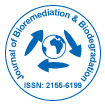Harnessing Fungi for Bioremediation Addressing Emerging Pollutants in Aquatic Environments
*Corresponding Author: Azzanni Marlon, Interdisciplinary Ecology Group, Department of Biology, University of the Balearic Islands, Spain, Email: Azzanni_m@gmail.comReceived Date: Jan 01, 2025 / Published Date: Jan 30, 2025
Citation: Azzanni M (2025) Harnessing Fungi for Bioremediation AddressingEmerging Pollutants in Aquatic Environments. J Bioremediat Biodegrad, 16: 663.
Copyright: © 2025 Azzanni M. This is an open-access article distributed underthe terms of the Creative Commons Attribution License, which permits unrestricteduse, distribution, and reproduction in any medium, provided the original author andsource are credited.
Abstract
Emerging pollutants, including pharmaceuticals, personal care products, and industrial chemicals, are increasingly B i o contaminating aquatic ecosystems, posing significant threats to water quality, biodiversity, and public health. Fungal-based bioremediation has emerged as a promising strategy for addressing these pollutants due to fungi's unique metabolic capabilities, including the secretion of extracellular enzymes that can degrade complex organic compounds. This review explores the potential of harnessing fungi for the bioremediation of emerging pollutants in aquatic environments. It focuses on the key fungal species involved in pollutant degradation, the enzymatic pathways utilized, and the environmental factors that influence fungal activity. The paper also discusses various bioremediation techniques such as bioaugmentation and mycoremediation, which utilize fungi to enhance the breakdown of contaminants in aquatic systems. Despite its potential, challenges remain in optimizing fungal-based bioremediation methods, including issues of scalability, environmental compatibility, and the need for further research on fungal strain selection and genetic engineering. This review provides insights into the current state of fungal bioremediation in aquatic ecosystems and suggests future directions for overcoming existing challenges and enhancing the effectiveness of these bioremediation strategies.

 Spanish
Spanish  Chinese
Chinese  Russian
Russian  German
German  French
French  Japanese
Japanese  Portuguese
Portuguese  Hindi
Hindi 
